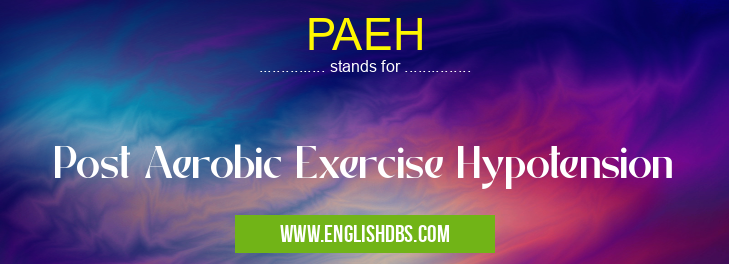What does PAEH mean in UNCLASSIFIED
PAEH stands for Post Aerobic Exercise Hypotension, which is a physiological response characterized by a significant decrease in blood pressure after prolonged aerobic exercise. It is a common phenomenon observed in individuals who engage in intense or prolonged endurance exercises, such as running, cycling, or swimming. PAEH is a temporary condition that typically occurs within minutes to hours after exercise and resolves gradually.

PAEH meaning in Unclassified in Miscellaneous
PAEH mostly used in an acronym Unclassified in Category Miscellaneous that means Post Aerobic Exercise Hypotension
Shorthand: PAEH,
Full Form: Post Aerobic Exercise Hypotension
For more information of "Post Aerobic Exercise Hypotension", see the section below.
Mechanism
During aerobic exercise, the body undergoes several physiological adaptations to meet the increased demand for oxygen and energy. These adaptations include vasodilation, increased blood flow to active muscles, and increased heart rate. After exercise, these adaptations gradually reverse, leading to a decrease in blood pressure. Additionally, the release of vasodilatory substances, such as nitric oxide, during exercise can further contribute to PAEH.
Symptoms
PAEH is usually asymptomatic, but some individuals may experience mild symptoms, including:
- Dizziness
- Lightheadedness
- Nausea
- Fatigue
- Blurred vision
- Confusion
Management
PAEH typically does not require medical intervention and resolves on its own within a few hours. However, if symptoms are severe or persistent, it is advisable to consult a healthcare professional. Simple measures to manage PAEH include:
- Gradually reducing the intensity and duration of exercise
- Staying hydrated by drinking plenty of fluids
- Eating a balanced diet
- Getting adequate rest
- Avoiding alcohol and caffeine
Essential Questions and Answers on Post Aerobic Exercise Hypotension in "MISCELLANEOUS»UNFILED"
What is Post Aerobic Exercise Hypotension (PAEH)?
PAEH is a temporary drop in blood pressure that occurs after aerobic exercise. It is a normal physiological response to exercise and is not a cause for concern.
What causes PAEH?
PAEH is caused by a combination of factors, including:
- Vasodilation (widening of blood vessels) in the legs and arms
- Redistribution of blood flow to the skin and muscles
- Decreased heart rate
- Increased production of vasodilator hormones
How long does PAEH last?
PAEH typically lasts for 1-2 hours after exercise. However, it can last longer in some individuals, especially if they are dehydrated or have underlying cardiovascular conditions.
What are the symptoms of PAEH?
The symptoms of PAEH include:
- Dizziness
- Lightheadedness
- Blurred vision
- Nausea
- Fatigue
- Weakness
How can I prevent PAEH?
You can prevent PAEH by:
- Staying hydrated by drinking plenty of fluids before, during, and after exercise
- Gradually increasing the intensity and duration of your exercise sessions
- Avoiding strenuous exercise in hot or humid conditions
- Consulting with a healthcare professional if you have any underlying cardiovascular conditions
When should I see a doctor about PAEH?
You should see a doctor if you experience the following symptoms:
- Severe dizziness or lightheadedness
- Blurred vision
- Chest pain
- Shortness of breath
- Nausea and vomiting
Final Words: PAEH is a normal physiological response to aerobic exercise and is not a cause for concern. Understanding the mechanism and symptoms of PAEH can help individuals manage the condition effectively and enjoy the benefits of regular exercise without adverse effects.
